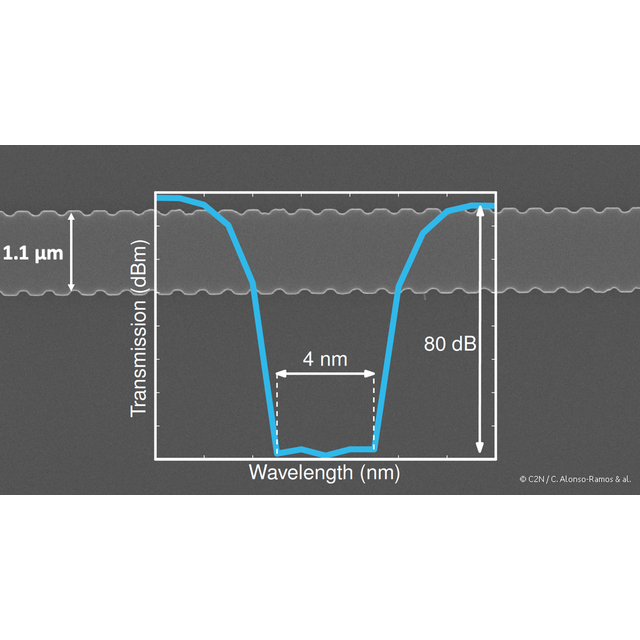Physicists at C2N and Institut de Physique de Nice have found a simple and generic strategy to overcome one of the major limitations in the fabrication of on-chip filters. They experimentally demonstrated an optical rejection exceeding 80 dB, without the need for any active tuning, enabling photonic noise suppression in quantum circuits.
Quantum information science holds an immense potential for high-impact applications like data processing or secure communications. In this context, silicon photonics is considered as an enabling technology for the scaling up of these quantum applications, as it would allow the low-cost and large volume fabrication of smart quantum chips implementing multiple functionalities. In these circuits, the first step is to generate entangled photon pairs from a strong optical pump through optical nonlinear effects in silicon. Then, these pairs can be manipulated, taking advantage of the high-performance building blocks already available in silicon photonics technology. However, the performance of on-chip silicon-based quantum circuits is hampered by photonic noise arising from the substantially higher pump intensity compared to that of the photon-pairs. On-chip suppression of this noise remains a challenge. Indeed, the only demonstration of on-chip pump rejection in a silicon quantum circuits has required cascading of two chips. This is mainly due to the limited rejection of state-of-the-art silicon filters.
A myriad of optical filters has been demonstrated for the silicon photonics technology, including cascaded resonators, interferometers and Bragg grating filters, which are able to reflect particular wavelengths of light and transmit all others. Although theoretical designs can achieve remarkably large rejection levels, practical implementations is typically limited to 30-60 dB rejection by fabrication imperfections. Even small deviations in device dimensions can produce large phase errors resulting in destructive interferences that distort the filter response. This effect is accentuated in silicon photonics filters by the high-index contrast between the silicon and the cladding. Active phase tuning can partially alleviate this detrimental effect at the cost of increased fabrication and operation complexity.
In a work published in July 2019 in Laser & Photonics Reviews journal, a team of researchers at C2N Photonics Department in collaboration with Institut de Physique de Nice, presented a new strategy for the on-chip implementation of high-rejection silicon filters, obviating the need for active tuning. The proposed approach exploits modal engineering in waveguide Bragg gratings to make the device immune to phase errors. Bragg filters rely on a periodic corrugation in the waveguide to reflect back the light at a specific wavelength, thereby implementing a notch in the transmission spectrum. While conventional Bragg gratings couple back-reflections in the fundamental waveguide mode, in this novel approach, the waveguide gratings are shaped to couple the Bragg back-reflections into a high-order spatial mode. Then, different Bragg gratings are separated by single-mode waveguides. Back-reflections, propagating in a high-order mode are radiated away in single-mode waveguides interconnecting adjacent filter stages, precluding destructive interferences. It turns out that such simple and generic strategy overcomes one of the major limitations of on-chip filters.
The filters were fabricated in the C2N Technology Facility, and the experimental characterization was performed at C2N and Institut de Physique de Nice. The complementary skills of both teams were key to experimentally demonstrate an optical rejection exceeding 80 dB, enabling photonic noise suppression in quantum circuits. Moreover, this is the highest rejection ever reported for a passive silicon filter. We foresee that these high-rejection optical filters will expedite the development of a new generation of high-performance nanophotonic quantum circuits exploiting key advantages of silicon photonics.
References:
Coherency-broken Bragg filters: overcoming on-chip rejection limitations
Dorian Oser1, Florent Mazeas2, Xavier Le Roux1, Diego Perez-Galacho1, Olivier Alibart2, Sebastien Tanzilli2, Laurent Labonte2, Delphine Marris-Morini1, Laurent Vivien1, Eric Cassan1 and Carlos Alonso-Ramos1
Laser & Photonics Reviews (July 2019)
DOI: https://doi.org/10.1002/lpor.201800226
1 Centre de Nanosciences et de Nanotechnologies (CNRS, Université Paris-Saclay)
2 Institut de Physique de Nice - INPHYNI (CNRS / Université de Côte d'Azur)
Contact:
- Carlos Alonso-Ramos, CNRS researcher at C2N
Figure: Scanning electron microscope image of fabricated Bragg filter (background SEM picture) and measured transmittance showing record 80 dB rejection (graph). © C2N / C. Alonso-Ramos & al.









